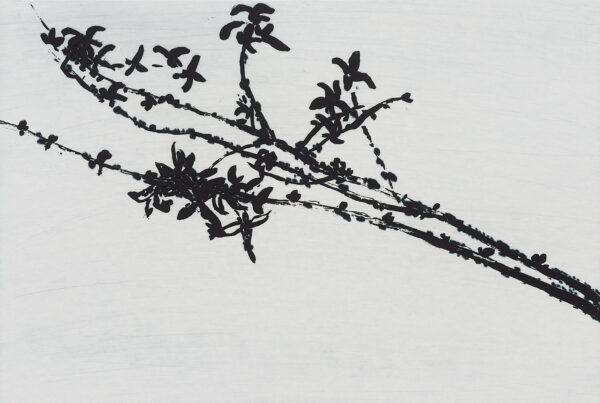그려보다
2024. 12. 04 - 12. 31 | [GALLERIES] GALLERY MAC
그려보다; ‘선(線)’과 ‘선(禪)’의 시간

Installation view
‘그려보다’
이번 김은주 작가 개인전의 전시명이자 작가의 작품명이기도 한 이 단순하고 명료한 문장 속엔 무수한 세월을 연필 하나로 그어온 수많은 ‘선(線)’과 그 선을 그리며 쌓아온 ‘선(禪)’의 시간이 축적되어 있다.
‘선(線)’
1965년 부산에서 나고 자란 김은주 작가는 30년이 넘는 시간 동안 오로지 종이에 연필 하나만으로 작업을 이어왔다. 90년도부터 2000년대 초반까지의 초기 작업은 ‘인체’가 주를 이루며 ‘날 것’ 같은 강렬함과 ‘날 선’ 연필 선이 화면에 거침없이 드러난다. 보는 이를 위협하듯 폭 20m가 넘는 벽면 전체를 덮어버린 거대한 군상(群像)과 규격화된 화면 밖으로 벗어나려는 듯 용쓰며 꿈틀대는 인체의 형상 속에서 그녀의 삶을 위협하는 사회적 통념이나 부조리에 대한 분노와 저항, 동시에 인간이라는 존재 그 자체의 존엄성을 확인하고자 했던 작가의 젊음을 읽을 수 있다.
2000년대 중반으로 넘어가면 인체로 영원할 것 같던 작가의 화면에 거대한 파도, 그리고 그 파도를 일으킨 바람이 느껴지는 흩날리는 이파리와 꽃이 등장한다. 너른 바다와 같던 아버지의 죽음과 평생 곁을 함께 한 고향 바다의 바람은 작가의 호흡과 리듬이 되었고, 그리고자 하는 대상은 그리는 행위 그 자체로 치환된다. 흰 화면과 무수히 쌓여가는 선, 그 행위를 지속하는 일. 반복적인 선 긋기와 중첩이라는 노동집약적이고 수행과도 같은 작업 과정은 작가의 내면 깊숙한 곳에서부터 태동한 생명력이자 에너지의 발현이다.

그려보다(Try to draw) 230619, 2023, Pencil on paper, 120 x 90cm
‘선(禪)’
긋고 또 그어진 선은 빛의 각도에 따라 양감과 일렁이는 듯한 느낌을 주며, 하얀 종이 위 그어진 검고 빛나는 형상은 바탕과 서로 대조를 이루며 부각되기도 하고 여백의 미를 살리기도 하는 상호보완적 존재로 자리한다. 작품은 파도, 화병, 꽃이라는 형상으로 완성되지만, 이 형상은 단지 형상일 뿐, 작가의 말을 빌리면 ‘꽃은 꽃이 아니고, 화병은 화병이 아니며, 파도는 파도가 아니다’. 그려진 대상이 무엇인지는 더 이상 작가에게 중요한 문제가 아니다. ‘반복적 선 긋기’라는 무념무상(無念無想)의 작업 과정 속에서 그리는 자신마저 잊고 일체의 생각에서 벗어나 ‘그리는 행위’와 하나 되는 것. 귀가 순해져 모든 말을 객관적으로 듣고 이해할 수 있는 나이라는 이순(耳順)에 접어든 작가에게 주어진 오늘의 과업일 것이다.
중국의 불경 연구가 페이융은 ‘수행’을 ‘이 세상의 모든 형태와 관념에 흔들리지 않고 자신의 본래 모습 안에서 평온하게 머물며 생명 자체의 희열을 느끼고 본질을 꿰뚫어 보기 위함이다’라고 말한다. 겉으로 드러나거나 보여지는 것, 즉 현상의 덧없음을 알고 어느 것에도 미혹되지 않는 마음을 갖기 위해 수행하다 보면 고통과 번뇌 가득한 현생에서 조금이나마 안정과 평정심을 갖게 된다는 말일 것이다. 김은주 작가가 앞서 말한 ‘꽃은 꽃이 아니고, 화병은 화병이 아니며, 파도는 파도가 아니다’는 말과 일맥상통하며, 그저 좋아서 시작한 그녀의 ‘그려보는’ 행위가 30년이 넘도록 지속되는 수행과도 같은 ‘긋는’ 행위로 이어지는 과정 속에서 그녀의 작업이 관람자로 하여금 큰 울림을 주는 이유이기도 하다.
맥화랑 김정원 큐레이터, 2024
맥화랑
부산시 해운대구 달맞이길117번나길 162, 2층
051-722-2201
WEBSITE INSTAGRAM Facebook Youtube Artsy
[GALLERIES] GALLERY MAC
- Dates
- 2024. 12. 04 - 12. 31










